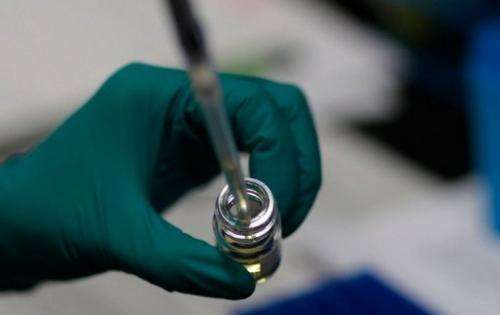Australian study turns HIV against itself (Update)

An Australian scientist said Wednesday he had discovered a way to turn the HIV virus against itself in human cells in the laboratory, in an important advance in the quest for an AIDS cure.
David Harrich from the Queensland Institute of Medical Research said he modified a protein in HIV that normally helps the virus spread, into a "potent" inhibitor.
The protein was introduced to immune cells targeted by the human immunodeficiency virus (HIV), where it slowed the reproduction of the virus after infection.
The experiments were conducted in a lab dish, and thorough testing on lab animals is needed before any human trials can begin.
"I have never seen anything like it. The modified protein works every time," said Harrich.
Harrich's team, whose study is published in the journal Human Gene Therapy, said the modified protein dubbed Nullbasic inhibited virus replication about eight- to ten-fold in some cells.
"If this research continues down its strong path, and bear in mind there are many hurdles to clear, we're looking at a cure for AIDS," the researcher said.
Commenting on the study, Frank Wegmann, an Oxford University HIV vaccine researcher, told AFP a Nullbasic-based drug was "quite far from application".
Creating a drug would be challenging, he said, as it would require introducing "designed" information into the genes of people to be treated.
"The immune cells of the blood are the primary cells which are infected by HIV and if you want to have a cure with this new protein, you need to... get every immune cell to make this protein," he explained.
This would require gene therapy—a complicated, rare, potentially dangerous and very expensive option.
"They (the Australian researchers) have partly addressed that question. They have partly tested that (gene therapy), but not really in patients or in infected people, only in the lab."
Harrich said Nullbasic held promise for curbing the spread of the virus as well as for treating people who already have AIDS, and described it as "fighting fire with fire".
"The virus might infect a cell but it wouldn't spread," he said.
"You would still be infected with HIV, it's not a cure for the virus, but the virus would stay latent, it wouldn't wake up, so it wouldn't develop into AIDS.
"With a treatment like this, you would maintain a healthy immune system."
An HIV-infected person is said to have AIDS when their count of CD4 immune system cells drops below 200 per microlitre of blood or they develop any one of 22 opportunistic infections like cancer or tuberculosis as a result.
Most people infected with HIV, if left untreated, would develop AIDS about 10 to 15 years later, according to the UN. Antiretroviral treatments can prolong this window period.
The new Nullbasic therapy, if proven, could see the spread of HIV halted indefinitely, bringing an end to the deadly condition, said Harrich.
Using a treatment based on a single protein could spell an end to onerous multiple drug regimes for HIV patients, meaning a better quality of life and lower costs.
Animal trials are due to start this year.
Even if all goes according to plan, said Wegmann, a Nullbasic-based treatment was probably about 10 years off.
"There are many other potential strategies towards a cure, but so far nothing works and it's not clear whether anything will ever work," he said.
"One really has to wait for results of animal studies and clinical trials to really judge this."
UN figures show the number of people infected with HIV worldwide rose to 34 million in 2011 from 33.5 million in 2010.
The vast majority (23.5 million) live in sub-Saharan Africa, with another 4.2 million in South and Southeast Asia.
There were 1.7 million AIDS-related deaths worldwide in 2011—24 percent fewer than in 2005 and nearly six percent below the 2010 level.
New HIV infections have at least halved in 25 low and middle income countries over the past decade.
The UN said in November that achieving zero new infections in children appeared increasingly possible.
More information: Paper: www.ncbi.nlm.nih.gov/pubmed/23298160
(c) 2013 AFP
















